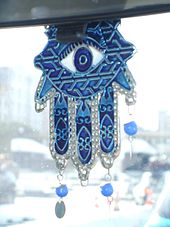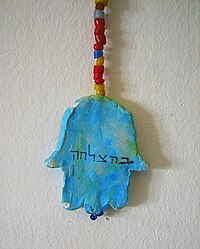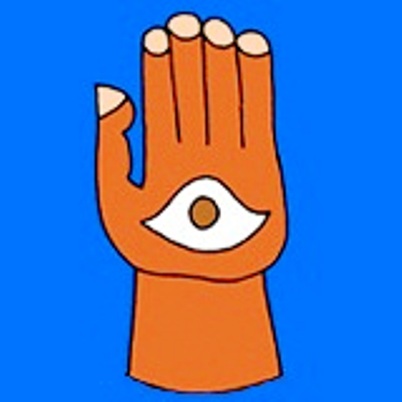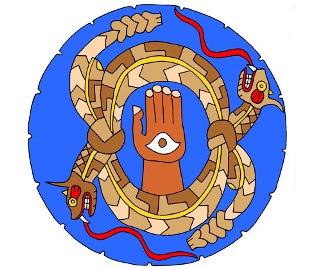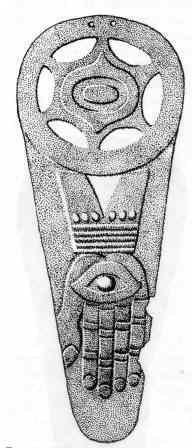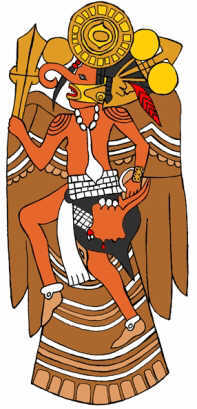
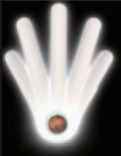
Rough Notes:
Hamsa
The hamsa (Arabic: خمسة khamsah, Hebrew: חַמְסָה, also romanized khamsa, Berber: ⵜⴰⴼⵓⵙⵜ tafust), is a palm-shaped amulet popular throughout the Middle East and North Africa and commonly used in jewelry and wall hangings.[1][2] Depicting the open right hand, an image recognized and used as a sign of protection in many times throughout history, the hamsa is believed by some, predominantly Jews, Christians and Muslims, to provide defense against the evil eye. It has been theorized that its origins lie in Ancient Egypt or Carthage (modern-day Tunisia) and may have been associated with the goddess Tanit.[3]
Khamsah is an Arabic word that means "five", but also "the five fingers of the hand".[4][5][6]
The Hamsa is also known as the Hand of Fatima after the daughter of the prophet Muhammad.[7]
Contents
[hide]
History[edit]
Early use of the hamsa has been traced to ancient Mesopotamia (modern-day Iraq) as well as ancient Carthage[citation needed] (modern day Tunisia). A universal sign of protection, the image of the open right hand is seen in Mesopotamian artifacts in the amulets of the goddess Ishtar or Inanna.[2] Other symbols of divine protection based around the hand include the Hand-of-Venus (or Aphrodite), the Hand-of-Mary, that was used to protect women from the evil eye and/or boost fertility and lactation, promote healthy pregnancies and strengthen the weak.[2] In that time, women were under immense pressure and expectation to become mothers.[8] The woman's upbringing was centered on becoming a mother as an exclusive role, and it indicated child bearing as necessary.[9] It was also thought that marriage was a sense of protection for both the man and the woman.[10] In Jewish culture, the hamsa is associated with the number five because of the five fingers depicted on the hand. [11]
One theory postulates a connection between the khamsa and the Mano Pantea (or Hand-of-the-All-Goddess), an amulet known to ancient Egyptians as the Two Fingers. In this amulet, the Two Fingers represent Isis and Osiris and the thumb, their child Horus and it was used to invoke the protective spirits of parents over their child.[2] Another theory traces the origins of the hamsa to Carthage (Phoenicia, modern Tunisia) where the hand (or in some cases vulva) of the supreme deity Tanit was used to ward off the evil eye.[12] According to Bruno Barbatti, at that time this motive was the most important sign of apotropaic magic in the Islamic world, though many modern representations continue to show an obvious origin from sex symbolism.
This relates to the belief that God exists in everything. Another meaning of this symbol relates to the sky god, Horus. It refers to the eye of Horus, which means humans cannot escape from the eye of conscience. It says that the sun and moon are the eyes of Horus. The Hand of Fatima also represents femininity, and is referred as the woman's holy hand. It is believed to have extraordinary characteristics that can protect people from evil and other dangers.[13]
The hamsa's path into Jewish culture, and its popularity particularly in Sephardic and Mizrahi Jewish communities, can be traced through its use in Islam.[2][12][14] This "favourite Muslim talisman" became a part of Jewish tradition in North African and Middle Eastern Muslim countries.[15] The symbol of the hand appears in Kabbalistic manuscripts and amulets, doubling as the Hebrew letter "Shin", the first letter of "Shaddai", one of the names referring to God.[16] The use of the hamsa in Jewish culture has been intermittent, utilized often by Sephardic Jews during the late nineteenth and early twentieth centuries[11], then less and less over time into the mid-twentieth century. However, the hamsa has been present in Judaism dating all the way back to Biblical times, where it is referenced in Deuteronomy 5:15, stated in the Ten Commandments as the "strong hand" of God who led the Jews out of Egypt.[11] The hamsa is later seen in Jewish art as God's hand reaching down from heaven during the times of late antiquity, the Byzantine period, and even medieval Europe. Evidence has also emerged of the hamsa being used by Jews from medieval Spain, often associated with "sympathetic magic".[11] Historians such as Shalom Sabar believe that after the Jewish expulsion from Spain in 1492, exiled Jews likely used the hamsa as protection in the foreign lands they were forced to relocate to, however this assumption has been difficult to prove.[11] According to Sabar, the hamsa has also been used later in Europe "...as a distinctive sign of the priesthood, especially when they wished to show that a person was of priestly descent...".[11]
The khamsa holds recognition as a bearer of good fortune among Christians in the region as well. Levantine Christians call it the hand of Mary (Arabic: Kef Miryam, or the "Virgin Mary's Hand").[17][18] 34 years after the end of Islamic rule in Spain, its use was significant enough to prompt an episcopal committee convened by Emperor Charles V to decree a ban on the Hand of Fatima and all open right hand amulets in 1526.[2]
Symbolism and usage[edit]
The Hand (Khamsa), particularly the open right hand, is a sign of protection that also represents blessings, power and strength, and is seen as potent in deflecting the evil eye.[2][19] One of the most common components of gold and silver jewelry in the region,[20] historically and traditionally, it was most commonly carved in jet or formed from silver, a metal believed to represent purity and hold magical properties.[2][21] It is also painted in red (sometimes using the blood of a sacrificed animal) on the walls of houses for protection,[22][23] or painted or hung on the doorways of rooms, such as those of an expectant mother or new baby.[2] The hand can be depicted with the fingers spread apart to ward off evil, or as closed together to bring good luck.[24] Highly stylized versions may be difficult to recognize as hands, and can consist of five circles representing the fingers, situated around a central circle representing the palm.[24]
Used to protect against evil eye, a malicious stare believed to be able to cause illness, death or just general unluckiness, hamsas often contain an eye symbol.[21][25] Depictions of the hand, the eye or the number five in Arabic (and Berber) tradition are related to warding off the evil eye, as exemplified in the saying khamsa fi ainek ("five [fingers] in your eye").[25] Raising one's right hand with the palm showing and the fingers slightly apart is part of this curse meant "to blind the aggressor".[22] Another formula uttered against the evil eye in Arabic, but without hand gestures, is khamsa wa-khamis ("five and Thursday").[26][27] As the fifth day of the week, Thursday is considered a good day for magic rites and pilgrimages to the tombs of revered saints to counteract the effects of the evil eye.[28]
Due to its significance in both Arabic and Berber culture, the hamsa is one of the national symbols of Algeria and appears in its emblem. It is also the most popular among the different amulets(such as the Eye and the Hirz — a silver box containing verses of the Quran) for warding off the evil eye in Egypt.[20] Egyptian women who live in baladi ("traditional") urban quarters often make khamaysa, which are amulets made up of five (khamsa) objects to attach to their children's hair or black aprons. The five objects can be made of peppers, hands, circles or stars hanging from hooks.[23]
Although significant in Arabic and Berber culture, the Jewish people have long interpreted and adopted the symbol of the hand with great importance since the Ten Commandments. A portion of these commandments state that "Lord took Israel out of Egypt with a strong hand and an outstretched arm". [29] The "strong hand" is representative of the hamsa which rooted its relevance in the community then. The helping hand exemplified God's willingness to help his people and direct them out of struggle. Around the time of the Byzantine period, artists would depict God's hand reaching from up above. [30] God's hand from heaven would lead the Jewish people out of struggle, and the Jews quickly made a connection with the hamsa and their culture. The hand was identified in Jewish text, and acquired as an influential icon throughout the community.
Amongst the Jewish people, the hamsa is a very respected, holy, and common symbol. It is used in the Ketubah, or marriage contracts, as well as items that dress the Torah such as pointers, and the Passover Haggadah. [31] The use of the hand as images both in and out of the synagogue suggests the importance and relevance that the Jewish people associated with the hamsa. The hand decorated some of the most religious and divine objects and has since emerged from its uncommon phase.
At the time of the establishment of the State of Israel, the widespread use of the talisman by Mizrahi Jews was initially looked down upon by Ashkenazi communities, although use of the hamsa has become more common in recent decades. The hamsa has become a symbo in everyday Israeli life, and to a degree, a symbol of Israel itself.[32] It has come to be a symbol of secularity, and a trendy talisman; a "good luck" charm appearing on necklaces, keychains, postcards, telephone and lottery cards, and in advertisements.[32] It is also incorporated into high-end jewellery, decorative tilework and wall decorations.[32] Its use by Ashkenazi Jews outside of Israel both historically and contemporaneously is intermittent but not unknown.
Similar to the Western use of the phrase "knock on wood" or "touch wood", a common expression in Israel is "Hamsa, Hamsa, Hamsa, tfu, tfu, tfu", the sound for spitting, supposedly to spit out bad luck.[33]
At the Mimouna, a North African Jewish celebration held after Passover, tables are laid with various symbols of luck and fertility, with an emphasis on the number "5", such as five pieces of gold jewelry or five beans arranged on a leaf of pastry. The repetition of the number five is associated with the hamsa amulet.[34]
Gallery[edit]
-
Hamsa in the Tropenmuseum, Amsterdam
See also[edit]
References[edit]
- Jump up^ Bernasek et al., 2008, p. 12.
- ^ Jump up to:a b c d e f g h i Sonbol, 2005, pp. 355–359.
- Jump up^ Cuthbert, Roland (2015). The Esoteric Codex: Amulets and Talismans. Raleigh, NC: Lulu.com. p. 49. ISBN 978-1-329-50204-8.
- Jump up^ Zenner, 1988, p. 284.
- Jump up^ World Institute for Advanced Phenomenological Research and Learning (Belmont, Estados Unidos), 1991, p. 219.
- Jump up^ Drazin, 2009, p. 268.
- Jump up^ González-Wippler, Migene (1991). The Complete Book of Amulets & Talismans. St. Paul, MN: Llewellyn Publications. p. 173. ISBN 978-0-87542-287-9.
- Jump up^ "The World of Child Labor". Loretta E. Bass. Retrieved 15 September2013.
- Jump up^ Wadud, Amina (1999). Qur'an and Woman. New York: Oxford University Press. p. 64.
- Jump up^ Sechzer, Jeri (2004). ""Islam and Woman: Where Tradition Meets Modernity": History and Interpretations oyt? Yt? the f Islamic Women's Status". Sex Roles. 51 (5/6): 263. doi:10.1023/B:SERS.0000046610.16101.e0.
- ^ Jump up to:a b c d e f Sabar, Shalom (2010). "From Sacred Symbol to Key Ring: The Hamsa in Jewish and Israeli Societies". Littman Library of Jewish Civilization.
- ^ Jump up to:a b Silver, 2008, p. 201.
- Jump up^ Lenhart, Sandy. "Hand of Fatima Meaning - Origin and Variations". Ezine Articles. N.p., n.d. Web. 29 September 2013.
- Jump up^ "Hamsa Hand Symbology: What Is the Hamsa Hand?" (Hamesh, Chamsa, Khamsa). N.p., n.d. Web. 29 Sept. 2013.
- Jump up^ Shadur, Joseph and Jehudit (2002). Traditional Jewish Papercuts - An Inner Worlds of Art and Symbol. University Press of New England. p. 92. ISBN 9781584651659.
- Jump up^ EMAIL, Jewish Magazine. "Angels and Demons". Jewishmag.com. Retrieved 2013-06-25.
- Jump up^ Perennial Books, 1970, p. 186.
- Jump up^ Trumball, 1896, p. 77.
- Jump up^ Rajab, 1989, p. 116.
- ^ Jump up to:a b Badawi, 2004, p. 510.
- ^ Jump up to:a b Lynch and Roberts, 2010, p. 8.
- ^ Jump up to:a b Schimmel, p. 92.
- ^ Jump up to:a b Early, 1993, p. 116
- ^ Jump up to:a b Gomez, 1996, p. 54.
- ^ Jump up to:a b Ham and Bing, 2007, p. 385.
- Jump up^ Lent et al., 1996, p. 189.
- Jump up^ Shinar, 2004, p. 117.
- Jump up^ Houtsma, 1993, p. 897.
- Jump up^ Sabar, Shalom From Sacred Symbol to Key Ring: The Hamsa in Jewish and Israeli Societies, 141
- Jump up^ Sabar, Shalom From Sacred Symbol to Key Ring, 142
- Jump up^ Sabar, Shalom From Sacred Symbol to Key Ring, 144
- ^ Jump up to:a b c Nocke, 2009, pp. 133–134.
- Jump up^ "Jewish magic and superstition in Israel". Abc.net.au. 2010-05-22. Retrieved 2013-06-25.
- Jump up^ Bin-Nun, Yigal (8 April 2007). "Lady Luck". Haaretz. Retrieved 21 June2011.
Bibliography[edit]
- Badawi, Cherine (2004). Footprint Egypt (4th, illustrated ed.). Footprint Travel Guides. ISBN 978-1-903471-77-7.
- Bernasek, Lisa; Peabody Museum of Archaeology and Ethnology; Burger, Hillel S. (2008). Artistry of the everyday: beauty and craftsmanship in Berber art (Illustrated ed.). Peabody Museum Press, Harvard University. ISBN 9780873654050.
- Drazin, Israel (2009). Maimonides and the Biblical Prophets. Gefen Publishing House Ltd. ISBN 9789652294302.
- Evelyn A. Early (1993). Baladi women of Cairo: playing with an egg and a stone (Illustrated ed.). Lynne Rienner Publishers. ISBN 9781555872687.
- Gomez, Aurelia (1996). Crafts of Many Cultures: 30 Authentic Craft Projects from Around the World. Scholastic Inc. ISBN 9780590491822.
- "Jewish magic and superstition in Israel". Abc.net.au. 2010-05-22. Retrieved 2013-06-25.
- M. Th. Houtsma (1993). M. Th. Houtsma, ed. E.J. Brill's first encyclopedia of Islam, 1913–1936 (Reprint ed.). BRILL. ISBN 9789004097902.
- Lent, J. M.; Bearman, Peri J.; Qureshi, Hakeem-Uddeen (1997). The encyclopaedia of Islam, new edition (2nd ed.). Brill. ISBN 978-90-04-10795-3.
- Lenhart, Sandy (2011). "Hand of Fatima Meaning - Origin and Variations". Ezine Articles. February 17, 2011.
- Lynch, Patricia Ann; Roberts, Jeremy (2010). African Mythology A to Z (2nd, revised ed.). Infobase Publishing. ISBN 9781604134155.
- McGuinness, Justin (2002). Footprint Tunisia Handbook (3rd, illustrated ed.). Footprint Travel Guides. ISBN 978-1-903471-28-9.
- Nocke, Alexandra (2009). The place of the Mediterranean in modern Israeli identity (Illustrated ed.). BRILL. ISBN 9789004173248.
- Perennial Books (1970). Studies in comparative religion, Volumes 4–5. University of California.
- Rajab, Jehan S. (1989). Palestinian costume (Illustrated ed.). Kegan Paul. ISBN 978-0-7103-0283-0.
- Schimmel, Annemarie (1994). Deciphering the signs of God: a phenomenological approach to Islam. SUNY Press. ISBN 9780791419823.
- Shadur, Joseph; Shadur, Yehudit (2002). Traditional Jewish papercuts: an inner world of art and symbol (Illustrated ed.). UPNE. ISBN 9781584651659.
- Shinar, Pessah (2004). Modern Islam in the Maghrib. JSAI. ISBN 9789657258026.
- Silver, Alan (2008). Jews, Myth and History: A Critical Exploration of Contemporary Jewish Belief and Its Origins. Troubador Publishing Ltd. ISBN 978-1-84876-064-6.
- Sonbol, Amira El Azhary (2005). Beyond the exotic: women's histories in Islamic societies. Syracuse University Press. ISBN 9780815630555.
- Trumbull, Henry Clay (1896). The threshold covenant: or, The beginning of religious rites (2nd ed.). C. Scribner's.
- World Institute for Advanced Phenomenological Research and Learning (Belmont, Estados Unidos) (1991). Anna-Teresa Tymieniecka, ed. Roman Ingarden's aesthetics in a new key and the independent approaches of others: the performing arts, the fine arts, and literature, Volume 3. Springer. ISBN 9780792310143.
- Steinmetz, Sol (2005). Dictionary of Jewish usage: a guide to the use of Jewish terms. Rowman & Littlefield. ISBN 9780742543874.
- Zenner, Walter P. (1988). Persistence and flexibility: anthropological perspectives on the American Jewish experience (Illustrated ed.). SUNY Press. ISBN 9780887067488.
External links[edit]
 Media related to Khamsa at Wikimedia Commons
Media related to Khamsa at Wikimedia Commons
|
|
||||||||
|
